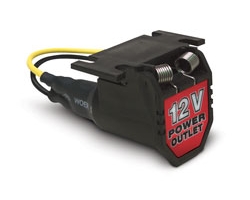Adding a new 12-volt accessories outlet/socket to your vehicle or 12-volt system is really pretty simple. The first step is to choose a suitable location that will serve our need. Next we would run appropriately sized wire from our install site to either the vehicles or 12-volt systems fuse block / panel.
For this example we will use 16ga wire, and this 12-volt add-on outlet.
Whether you start “feeding” from the power source or from the install site is entirely up to you. The higher location is usually much easier.So we will trim our positive and negative wires to the appropriate length and tape the ends together side by side. This will provide a nice clean end to begin feeding through the wall, cabinet, body panel etc.
You should also checkout our how to titled How To Add a 12 Volt Outlet
Work these wires gently around existing parts and pieces that might be in the way. Once you have the wires run it’s a good idea to go over and wire tie them into place or secure them somehow. Do not connect them to live power just yet!
An inline fuse is not necessary but we recommend that you use one. Make sure that you can get to it easily in the future. For 16ga wire the fuse size should be no more than 22amps.
We are using a 12-volt blade fuse holder by Bussmann which can easily handle our 22amp max draw. Rather than crimping we prefer to use solder and heat shrink tubing when connecting our inline fuse. We will also use solder and heat shrink tubing when we connect the 16ga wire we have run to the fuse block or battery.
Once you have the wires and fuse holder soldered up it’s time to hook it up to live power. Using the appropriate crimp ends for your fuse block or 12-volt power distribution block prepare the positive wire end. The positive wire end should be plugged into an available auxiliary fuse slot in the fuse block or distribution block. The negative wire should be connected last and should be hooked up to the vehicles chassis or another location that is grounded to the chassis.
It’s now time to fuse this set up and test it! Choose a fuse close to 20 amps to use here. The socket and wiring can handle it. Once the fuse is in test the new 12-volt outlet with a multi-meter. The center is positive and the outer walls of the outlet are the negative. Once you verify that there is good power there, plug something in! Try something small and inexpensive first like a cellphone charger.
Congratulations! You now have an additional 12-volt auxiliary power outlet.


